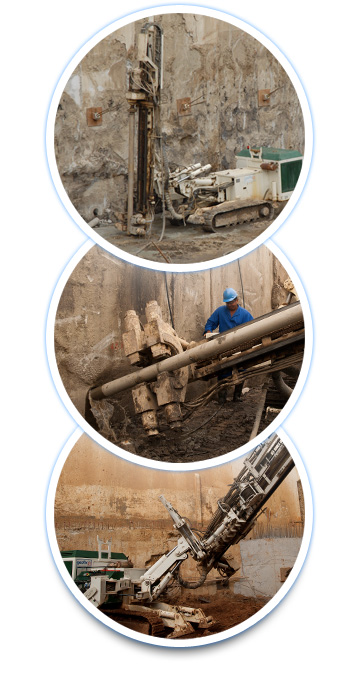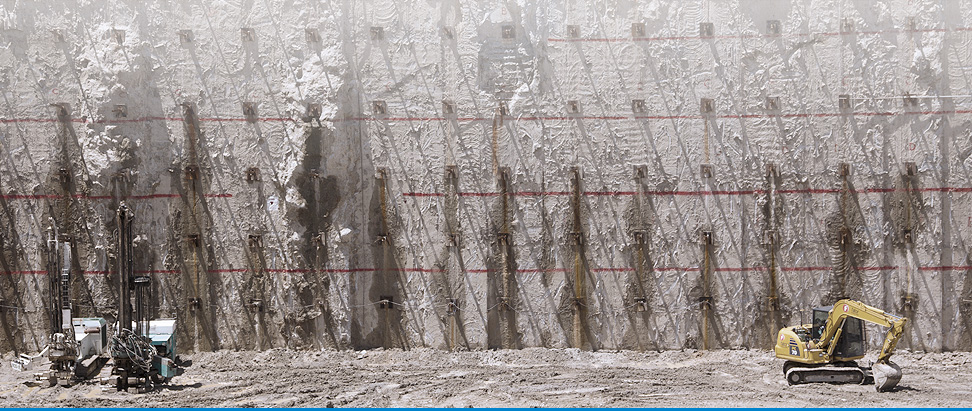Tiebacks
Tieback is a device capable of transmitting tensile forces applicable to a tough region of the ground through the bulb. The tractive effort applied to the Tieback head is transferred to the bulb through the free section.
The tiebacks can be temporary, with an estimated term of use of less than two years (from their installation) and permanent, with a term of use of more than two years.
The tiebacks are composed of:
• Head: Head: which is the part that supports the whole structure (main components: support plate and wedge-grade anchor block);
• Free section: transfers the traction effort applied on the tieback head to the bulb (anchored stretch). The steel must be isolated from the mixture of cement, silica, water and additives;
• Anchored section: transfers the traction effort from the tieback to the ground. In this stretch, the steel is surrounded by the mixture of cement, silica, water and additives (binder).
Geofix makes tiebacks with a capacity of up to 150 ton-force (tf).

Advantages
Allows excavation of the work in the open air
EXECUTION METHODOLOGY AND CARE IMPLEMENTATION
In the execution of the tieback, we can highlight the following phases:
Before drilling a tieback, we must analyze the following aspects:
• Hole location;
• Leveling ground for positioning the drill;
• Possible interference behind the curtain, as well as removals (or deviations);
• Tightness check of the water supply network for the process;
• Drainage arrangements, collection and removal of water used in the process.
Drilling is performed with a drill, according to the slope and length considered in the project. This process is performed by washing (with water), using a coating.
In the case of rock drilling, an air compressor is required to use a hammer (with bits). At the end of the drilling, the interior must be cleaned to eliminate debris.
After cleaning the hole, the tieback itself is installed and this will be done manually. Such operation will be carried out under the supervision of the person in charge of this activity and the introduction process must be slow and careful, to avoid any damage to the tieback by excessive flexing or friction against the walls of the covering or the hole. In addition, precautions must be taken, such as not damaging the corrosion protection, not moving accessories (valves and spacers) and positioning the head at the correct height of the project.
Immediately after installing the tieback inside the hole, the first injection phase (sheathing) begins, which will consist of filling the hole with cement grout, without causing pressure. This injection phase will start with the introduction of a column of rods with a simple plug, inside the injection tubes of the tieback.
The plug is housed slightly above the deepest tieback valve, and water will circulate to remove any debris through this device. Then the cement grout is injected, until it pours through the hole. After a period of time not exceeding two hours, the inside of the tieback injection tube will be cleaned. By introducing a column through which water will circulate until the complete removal of the cement housed inside the tube.
When a minimum time interval of ten to twelve hours is reached after the sheathing execution, we have the start of the controlled pressure injection phase, also known as primary injection.
To apply the primary injection, a column of rods equipped with a double plug will be inserted inside the injection tube and the injection will start from the deepest valve. Primary injection initially requires sheathing rupture.
The pressure required for this rupture depends fundamentally on the simple compressive strength of each sheathing and its thickness. Once this ring is broken, the gauge pressure usually falls to a value that depends on the compactness or consistency of the surrounding soil.
The injection volumes and pressures will be those that guarantee the perfect anchoring of the fixed section of the tieback to the local ground.
For cases in which the injection pressures of certain valves do not reach values considered satisfactory, it will be necessary to apply the subsequent phases (secondary and possibly tertiary), until adequate injection pressures are achieved.
The time lag between consecutive injection steps will be in the order of ten to twelve hours. At the end of each injection phase, cleaning of the tieback injection tubes should always be carried out, in a manner similar to that described for the sheathing injection, always aiming to allow a new injection phase.
The criteria will be based on the characteristics of the soil where the tieback is being installed.
For the development of the injection activity, mixer sets and high turbulence agitators will be used. These units will have devices for filtering the grout, dosage and volume injected controls. Such sets will supply the high-pressure injection pumps, with an injection capacity of up to 60 liters per minute and equipped with pressure control gadgets within the range of 0 to 100 kgf / cm2.
The grout will be obtained by a simple mixture of water and Portland cement CP-II-E class 32, in the proportion a / c-0.5.
According to the Brazilian Standard (NBR 5629), all tiebacks of a work must be submitted to prestressing tests.
For tensioning and crimping of tiebacks, prestressing assemblies with pump and hydraulic drive jack will be used and capable of safely reaching the limit test loads.
The prestressing of the tiebacks will take into account a minimum curing time regarding the last injection phase. To control the deformations, independent references will be installed outside the area of influence of the prestressing.
The tests, their stages and stabilization times, the monitoring of displacements and the presentation of reports and graphs, etc., will be developed observing the requirements of NBR-5629, including the loading stages considered by this Standard (temporary or definitive tieback).
The data of the applied loads and the deformations observed in each stage will be noted in appropriate bulletins and load graphs x elastic and plastic displacement will be made, according to Standard NBR-5629.
When the tiebacks are inclined in relation to the wall to be supported, there will be a need to apply a grade wedge so that they work exclusively with traction without risk of bending.
Grade wedges are made of steel sheets and will present thicknesses and dimensions such that they are able to withstand the stresses predicted for prestressing tests and that also do not cause puncture in the structure that supports it.
The incorporation of the tieback into the structure can only be carried out definitively after the verification of its good performance through the receiving test.
The incorporation will be made through the final wedging of the wires or cordages properly tensioned, next to the support device of the tieback head. As a result, the load applied by the jack will be definitively transferred to the structure.

See other
services


